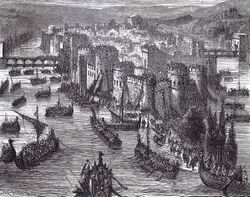Sacking of Umudin: Difference between revisions
Jump to navigation
Jump to search
No edit summary |
No edit summary |
||
| Line 21: | Line 21: | ||
|howmany2= 4,700+ | |howmany2= 4,700+ | ||
}} | }} | ||
[[Category:Flatstone]] | [[Category:Flatstone]] | ||
[[Category:History of Flatstone]] | [[Category:History of Flatstone]] | ||
[[Category:History of Kopen]] | [[Category:History of Kopen]] | ||
Revision as of 02:40, 27 January 2023
| Sacking of Umudin | |||
|---|---|---|---|
| Part of The First Kopen Uprising | |||
 Artists' rendition of the Sacking of Umudin in 1324. | |||
| Date | 1324-1325 | ||
| Location | |||
| Caused by | The city of Umudin had been placed under siege by Kopenist revolutionaries during the First Kopen Uprising. The desperation of the heretics resulted in the pillaging of the lands in and around the city of Umudin. | ||
| Goals | Surrender of the Umudin inner garrison | ||
| Methods | Looting, Siege, Wartime sexual violence | ||
| Status | Siege relieved by reinforcing Southern Ivili troops in 1325; Kopenist armies dispersed or annihilated. | ||
| Parties to the civil conflict | |||
| Lead figures | |||
| |||
| Number | |||
| |||
| Casualties | |||
| |||